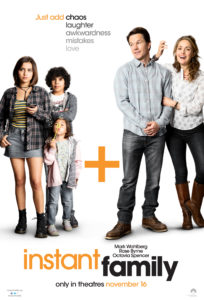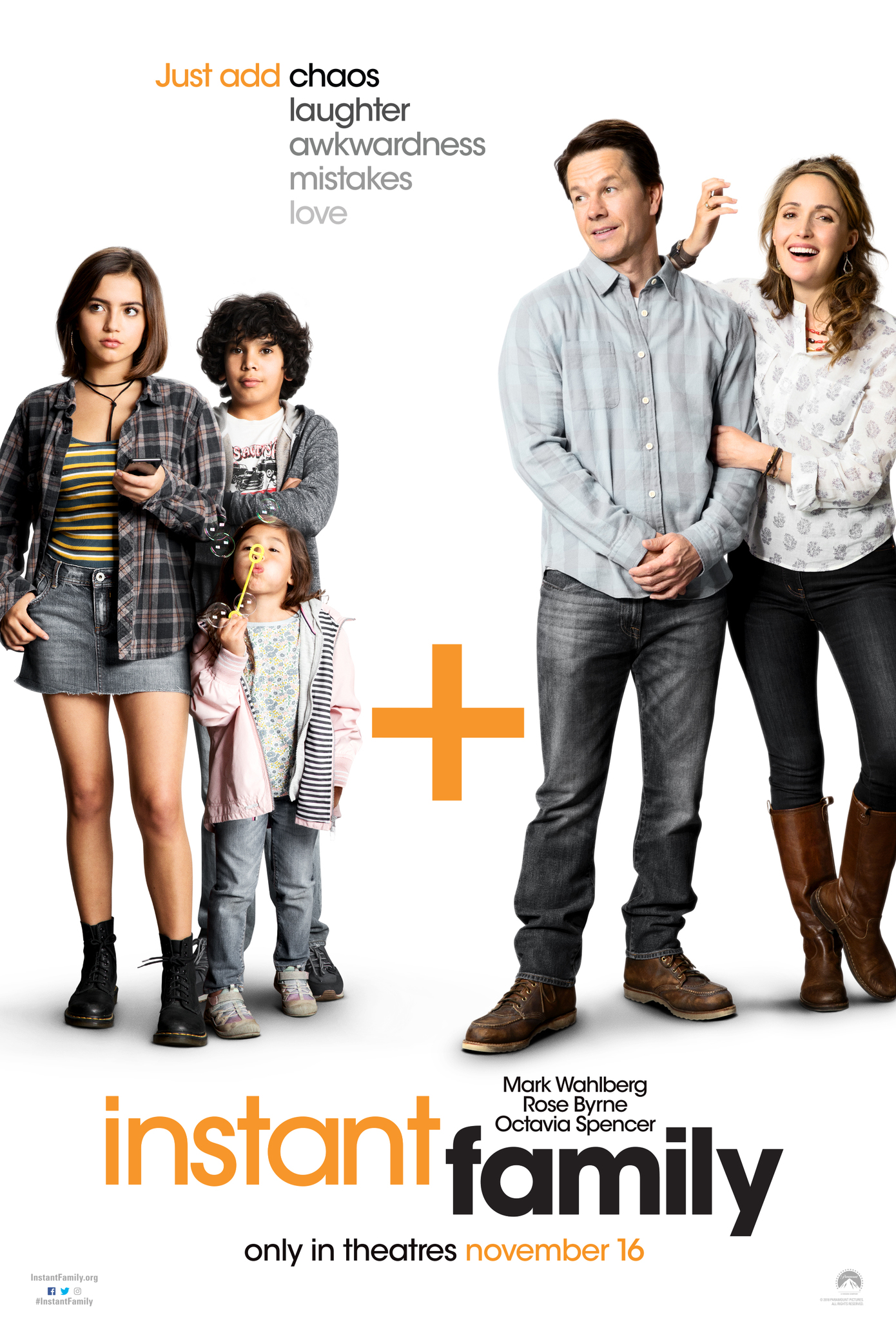Instant Family
Posted on November 15, 2018 at 5:04 pm
B +| Lowest Recommended Age: | Middle School |
| MPAA Rating: | Rated PG-13 for thematic elements, sexual material, language and some drug references |
| Profanity: | Some strong language |
| Alcohol/ Drugs: | References to drug abuse |
| Violence/ Scariness: | Tension and some peril and accidents, brief disturbing images of injuries, family confrontations, issues of foster care |
| Diversity Issues: | A theme of the movie |
| Date Released to Theaters: | November 16, 2018 |
| Date Released to DVD: | March 4, 2019 |

“Instant Family,” based in part on the real-life story of writer-director Sean Anders, tells us everything we need to know about Pete (Mark Wahlberg) and Ellie (Rose Byrne) in the first scene, as they race through a decrepit mess of a house thrilled at the possibilities only they can see. Their optimistic vision and instinctive teamwork will be needed when a half joking remark about adopting an older child to catch yup with their contemporaries leads Ellie to start looking at websites about foster parenting and then to being the drag-er to Pete’s drag-ee. “This is what we do! We see potential in things and fix them up!” But of course, as someone said, adults do not make children; children make adults. The parents get some fixing up, too.
After some foster parent training, they go to a “foster fair,” to meet some of the children who are available. They were not planning to foster a teen, but they are drawn to a remarkably self-possessed girl named Lizzy (Isabela Moner) (and a bit intimidated by her, too). The social workers (Tig Notaro and Octavia Spencer) tell them she has two younger siblings. They are daunted by the idea of going from zero kids to three all at once, but understand the importance of keeping them together and cannot resist their adorable photos. The next thing they know, they are calling out, “Kids! Dinner is ready!” and wondering whether it will be reassuring or intrusive to kiss them goodnight.
You can tell Anders (“Daddy’s Home”) has been through it and has spent time with other foster families. The film has well-chosen details of the two steps forward-one step back relationship with the children, especially Lizzie, who is used to taking care of her brother and sister herself and still hopes that their mother will come for them. It is frank about the issues of fostering children of different ethnicities, the ambivalent feelings about the possibility of the biological mother returning, and the moments when Pete and Ellie wonder if they’ve done the right thing, and if not loving the children immediately makes them horrible people. Ellie says at one point that she feels like she is babysitting someone else’s kids. And she’s right. They don’t become hers because a social worker says so or because a judge says so. They become hers because she does not give up. And because she fights for Lizzie. And because she brushes Lizzy’s hair so gently and lovingly.
Wahlberg and Byrne are perfectly cast and the tone and pacing are exactly right for depicting family life, where tears are mixed with laughter and laughter is mixed with tears. They are hilariously funny and also touching and moving. There’s great support from Notaro and Spencer and from Margo Martindale as a feisty grandmother, and Moner is excellent as Lizzy whether she’s being defiant, manipulative, protective, or vulnerable. This story could have been cloying or it could have been soap opera. But Anders and his cast make it into a genuinely heartwarming experience that makes us wish we could be part of their family, too.
Parents should know that this is a warm-hearted comedy that is frank about some of the issues presented in foster parenting and adoption including trauma and neglect, drug abuse, predatory behavior and sexting, with some strong language.
Family discussion: What were the biggest challenges Pete and Ellie faced and how well did they deal with them? What is the best way to help kids in the foster program?
If you like this movie, try: “Room for One More” with Cary Grant and his then-wife Betsy Drake


